Black Hills
 I recently read a book about the orphan trains, which ran between 1854 and 1929. During that time, approximately 250,000 orphaned, abandoned, and homeless children ride the train throughout the United States and Canada, to be placed with families who were looking for a child, or just as often, a worker for their farm. The orphan train movement was necessary, because at the time, it was estimated that 30,000 abandoned children were living in the streets in New York City. I had heard of the orphan trains, mostly from the movie called “Orphan Train,” but much of what really happened with those children was very new to me, and quite shocking.
I recently read a book about the orphan trains, which ran between 1854 and 1929. During that time, approximately 250,000 orphaned, abandoned, and homeless children ride the train throughout the United States and Canada, to be placed with families who were looking for a child, or just as often, a worker for their farm. The orphan train movement was necessary, because at the time, it was estimated that 30,000 abandoned children were living in the streets in New York City. I had heard of the orphan trains, mostly from the movie called “Orphan Train,” but much of what really happened with those children was very new to me, and quite shocking.
Today, while my husband, Bob Schulenberg and I were in the Black Hills, we rode the 1880 Train, as we almost always do when we are here. When they mentioned that the train had been 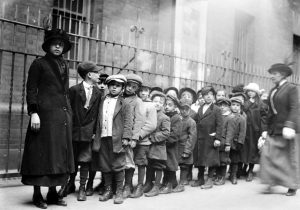 used in the movie “Orphan Train,” a fact that I had heard many times before, the stories from the book I had read came back to mind. My mind instantly meshed to train, the book, and the movie into one event.
used in the movie “Orphan Train,” a fact that I had heard many times before, the stories from the book I had read came back to mind. My mind instantly meshed to train, the book, and the movie into one event.
The children who traveled on the orphan trains were victims of circumstance, and they had no control over their lives at all. Each one hoped that their new family would be nice. The older ones didn’t have high hopes. The older boys pretty much knew that they would be farm hands. And most of them were right many were made to sleep in the barn, because they were thought to be thieves. If they were thieves, it was because they had to steal to survive. They did whatever it took to survive.
 As Bob and I rode the train today, in the eye of my imagination, I could picture what it must have been like to be one of those orphans. The were sitting there watching that big steam engine take them to someplace they didn’t know, and probably didn’t want to go. They didn’t have high hopes for a great future, but then again, the past wasn’t that great either. They were forced to make the best of a bad situation, and the people who were in charge didn’t really care what happened to them. They were just doing their jobs. I have ridden the 1880 Train many times before, but today, it felt a little bit different, somehow. I knew that I wasn’t an orphan riding that train, but I certainly felt empathy for the children who were.
As Bob and I rode the train today, in the eye of my imagination, I could picture what it must have been like to be one of those orphans. The were sitting there watching that big steam engine take them to someplace they didn’t know, and probably didn’t want to go. They didn’t have high hopes for a great future, but then again, the past wasn’t that great either. They were forced to make the best of a bad situation, and the people who were in charge didn’t really care what happened to them. They were just doing their jobs. I have ridden the 1880 Train many times before, but today, it felt a little bit different, somehow. I knew that I wasn’t an orphan riding that train, but I certainly felt empathy for the children who were.

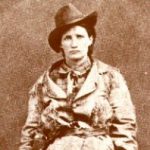 The Gold Rush affected many states and many people. Everyone headed west to try their luck, hoping to strike it rich. While the big strikes seemed to be in California, the Black Hills, and Alaska, there were many other places where miners struck it rich…and just as many where the miners went bust. It takes a special group of people to persevere in the gold rush years, and many went home broke, or found another way to cash in on the god rush, such as stores where the miners could buy supplies, or saloons, where they could drown their sorrows.
The Gold Rush affected many states and many people. Everyone headed west to try their luck, hoping to strike it rich. While the big strikes seemed to be in California, the Black Hills, and Alaska, there were many other places where miners struck it rich…and just as many where the miners went bust. It takes a special group of people to persevere in the gold rush years, and many went home broke, or found another way to cash in on the god rush, such as stores where the miners could buy supplies, or saloons, where they could drown their sorrows.
Wyoming had it’s share of gold mines and gold strikes too. Atlantic City was located in west central Wyoming, it was one of three mining towns in the area. The others were South Pass City, and Hamilton City. These towns sprung up as a result of the gold discovery at Spring Gulch in 1867. Hamilton City is located about three miles east of Atlantic City, but it could prove very difficult to locate, because early on in the town’s history, the townspeople unofficially renamed it to Miners Delight after the area’s largest and most productive mine, which carried the same name and was located on Peabody Hill.
The Miners Delight mine was founded by Jonathan Pugh. After a while, the town was officially changed to Miners Delight, since no one called it Hamilton City anyway. At first the mine was a rich enough producing mine to warrant a 10-stamp mill to be erected to crush the rock. The first mention of the town in newspapers appeared in July 1868 with the Sweetwater Mines newspaper describing it as: “…some thirty buildings are up, and more in course of construction. Spring Gulch is turning out the bright ore in very comfortable quantities,” and continues “Ten companies are at work in Spring Gulch…and all appear content with the result of their labors.”
Strangely, the owners of the Miners Delight mine found that recovering gold is more expensive than the gold is worth. After a short few years, the town’s population fell dramatically from its peak of some 75 residents. The Miners Delight Mine shut down in 1874, but soon reopened again…only to close again in 1882. The mining camp would endure good times and bad times over the next several decades, including the Great Depression. Over the years the mine produced over $5 million in gold ore…a relatively small amount as gold goes. The town was inhabited as late as 1960, but today it is nothing but abandoned ruins.
If you go there, you can expect to see rusting iron equipment, such as this old stove, and a couple of iron box screens, around the cabins of Miners Delight, Wyoming. It all seems like nothing much, but in the town’s heyday, it was even home to a couple of famous residents. Henry Tompkins Paige Comstock, would later discover the famous Comstock Lode in Nevada, and a young orphaned girl named Martha Jane Canary, who became known a Calamity Jane. As a child, Marth was adopted and moved with her new parents to Miners Delight. She liked the wild life in both Atlantic City and Miners Delight, and then in Deadwood, South Dakota.
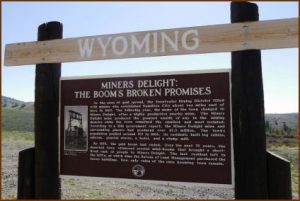
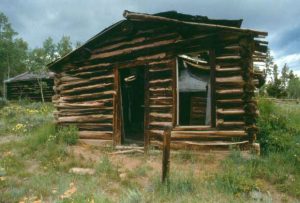 Today, the site is located on Bureau of Land Management property. Some preservation work has been done in order to keep the few remaining buildings standing, but the site is not being restored. Miners Delight is listed on the National Register of Historic Places. The site continues to preserve several cabins, one building that was said to have been a saloon, a baker, a barn, and a couple of outhouses. They are the last remnants of a long ago era.
Today, the site is located on Bureau of Land Management property. Some preservation work has been done in order to keep the few remaining buildings standing, but the site is not being restored. Miners Delight is listed on the National Register of Historic Places. The site continues to preserve several cabins, one building that was said to have been a saloon, a baker, a barn, and a couple of outhouses. They are the last remnants of a long ago era.
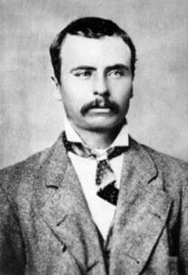 Deadwood, South Dakota maybe started out as an illegal town, but once it was established, there came a need for things like mail, supplies, and transportation, the latter of which brought the need for a stagecoach. The biggest problem with the stagecoach was the fact that the lawless element in the area thought it would be an easy target for robbery. The stagecoaches became a ride for the very brave. Soon it became apparent that the stagecoaches were going to need some protection.
Deadwood, South Dakota maybe started out as an illegal town, but once it was established, there came a need for things like mail, supplies, and transportation, the latter of which brought the need for a stagecoach. The biggest problem with the stagecoach was the fact that the lawless element in the area thought it would be an easy target for robbery. The stagecoaches became a ride for the very brave. Soon it became apparent that the stagecoaches were going to need some protection.
Daniel “Boone” May was born in Missouri in 1852. Going by the name of “Boone,” he was the son of Samuel and Nancy May, the seventh of nine children. Later, he moved with his family to Bourbon County, Kansas, where his father worked as a farmer. In 1876, “Boone” and his older brother moved to Cheyenne, Wyoming, where they worked in the freight business. During this time, the Black Hills were crawling with road agents and hostile Sioux Indians.It was a dangerous time to be working along the roadways in that area. Nevertheless, May did very well there, and he decided to buy a ranch between the Platte River and Deadwood by the end of that year.
“Boone’s” bravery and work ethic soon came to the attention of the stagecoach service, and he was soon recruited as a shotgun messenger for the Cheyenne and Black Hills Stage & Express Company. He also served as the station keeper at Robbers’ Roost in Wyoming Territory. Within just a few years, “Boone” was thought to have been in at least eight shooting incidents with outlaws. Many people said that he was the fastest gun in the Dakotas. His adventures soon became well known.
One of the first hold-ups “Boone” was involved in was in August, 1877, when a Deadwood Coach was intercepted at Robber’s Roost. On this occasion, even though “Boone” wanted to fight it out, he decided to lay down his weapons, because a woman and child were in the coach. The robbers made away with the passenger’s money, weapons and personal property. While they lost their things, I’m sure they decided that it was best to walk away with their lives. A short time later, “Boone” ran into one of the bandits, a man named Prescott Webb, in Deadwood and within no time, gunfire erupted between the two men. Though “Boone” was hit in the left wrist, he returned fire as Webb jumped on a horse to make his getaway. “Boone’s” shots hit Webb in the shoulder, and the horse several times, bringing it down. Webb was quickly arrested by Sheriff Seth Bullock and later that day, Webb’s companions who had aided in the robbery, were also arrested.
In 1878, stagecoaches known as “treasure coaches” were running regularly between Deadwood and Cheyenne. Their cargo was strong boxes filled with gold, as well as the U.S. Mail. These “treasure coach” stages often became the target of bandits, and after one of these coaches was held up on July 2, 1878, the U.S. Postal Service appointed a number of special agents to bring the outlaws to justice. “Boone” and ten other men were soon appointed as U.S. Deputy Marshals and equipped with good horses and ammunition. One of “Boone’s” first encounters with bandits as a U.S. Deputy Marshal occurred on the night of September 13, 1878. He and another messenger were trailing a Cheyenne bound coach which was approached by bandits near Old Woman’s Creek in the Wyoming Territory. “Boone” and another deputy, Zimmerman surprised the outlaws and shooting erupted. “Boone” wounded one bandit named Frank Towle and the others fled empty handed. Leaving their Towle wounded on the ground, the two messengers went after the other bandits but were unable to capture them. When they returned to the robbery site, Towle was gone.
On September 26, 1878, when “Boone” and other messengers were waiting to escort a coach at Beaver Station on the Wyoming-Dakota border, but the stage failed to show up. They went in search of the coach, and met another messenger who told them it had been robbed and a passenger killed. “Boone” quickly joined a posse to go after the outlaws, but they escaped. The following month, “Boone” learned of the hiding place of a robber named Archie McLaughlin and quickly went after him and his gang. Capturing them north of Cheyenne, the outlaws were sent under guard to Deadwood on the northbound coach. Unfortunately, the stage never make it, because on November 3, 1878, it was stopped by vigilantes who hanged Archie McLaughlin and another man named Billy Mansfield. The next month, “Boone” was in a posse that brought in a robber named Tom Price. The bandit tried to escape, and was wounded, and then was brought in. Late in 1879, “Boone” was sent to assist Special Agent William Llewellyn in the capture of a mail robber named Curley Grimes. They tracked the outlaw  to Elk Creek, located halfway between Rapid City and Fort Meade where they arrested him. That night, as the group neared Fort Meade, Grimes attempted to escape and was shot and killed by “Boone” and Llewellyn. By this time, “Boone” had made such a reputation for himself that he became a target for many of the outlaws who repeatedly tried to assassinate him, unsuccessfully. “Boone” also worked as a messenger for the Black Hills Placer Mining Company in the summer of 1880, and was said to have killed at least one robbers during this time. A short time later, “Boone” resigned from the company and left the Black Hills. He turned up in Santiago, Chili in 1883. He shot an army officer in 1891, he fled to Brazil. He died of yellow fever in Rio de Janeiro in 1910.
to Elk Creek, located halfway between Rapid City and Fort Meade where they arrested him. That night, as the group neared Fort Meade, Grimes attempted to escape and was shot and killed by “Boone” and Llewellyn. By this time, “Boone” had made such a reputation for himself that he became a target for many of the outlaws who repeatedly tried to assassinate him, unsuccessfully. “Boone” also worked as a messenger for the Black Hills Placer Mining Company in the summer of 1880, and was said to have killed at least one robbers during this time. A short time later, “Boone” resigned from the company and left the Black Hills. He turned up in Santiago, Chili in 1883. He shot an army officer in 1891, he fled to Brazil. He died of yellow fever in Rio de Janeiro in 1910.
 Anyone who has spent much time in the Black Hills has most likely seen Deadwood, and knows it to be a historic gambling town where many famous Wild West characters hung out and died. Legends like Wild Bill Hickok and Calamity Jane each left their mark. Hickok, a legendary man even in his own lifetime, was shot in the back of the head by Jack McCall, while playing poker at the No. 10 Saloon on August 2, 1876. Calamity Jane was renowned for her excellent marksmanship, as well as her preference for men’s clothing, and brash behavior.
Anyone who has spent much time in the Black Hills has most likely seen Deadwood, and knows it to be a historic gambling town where many famous Wild West characters hung out and died. Legends like Wild Bill Hickok and Calamity Jane each left their mark. Hickok, a legendary man even in his own lifetime, was shot in the back of the head by Jack McCall, while playing poker at the No. 10 Saloon on August 2, 1876. Calamity Jane was renowned for her excellent marksmanship, as well as her preference for men’s clothing, and brash behavior.
Deadwood also had, in addition to its tough individuals, others such as Reverend Henry W. Smith. Preacher Smith was the first Methodist minister to come to the Black Hills. Smith was mysteriously murdered on Sunday, August 20, 1876, while walking to Crook City to deliver a sermon. These individuals are just a few of the many notables buried in Mount Moriah Cemetary, which was established in 1877 or 1878.
That’s all well known to many people, but some may not know that the settlement of Deadwood began illegally in the 1870s on land which had been granted to the Native Americans. In 1874, Colonel George Armstrong Custer led an expedition into the Black Hills and announced the discovery of gold on French Creek near what is now Custer, South Dakota. That announcement ushered in the Black Hills Gold Rush and gave rise to the new and lawless town of Deadwood. In 1875, a miner named John Pearson found gold in a narrow canyon in the Northern Black Hills. This canyon became known as “Deadwood Gulch,” because of the many dead trees that lined the canyon walls at that time. The name stuck. Try as they might, the government couldn’t keep the situation under wraps, in order to honor the 1868 Treaty of Fort Laramie, which forever ceded the Black Hills to the Lakota-Sioux. The government dispatched several military units to forts in the surrounding area to keep people from entering the Hills. However, people illegally entered the area anyway, searching for gold or adventure. Despite the efforts of the military and federal government. They were driven by dreams and greed.
Once Deadwood was established, the mining camp was quickly swarming with thousands of prospectors searching for an easy way to get rich. Fred and Moses Manuel, claimed the Homestake Mine, which proved to be the most profitable in the area. Although the Manuels had been lucky, others were not so fortunate. Most of the early population was in Deadwood to mine for gold, but the lawless town naturally attracted a crowd of rough and shady characters too. These particular individuals made the early days of Deadwood rough and wild. 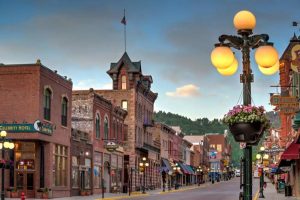 A mostly male population eagerly patronized the many saloons, gambling establishments, dance halls, and brothels. These establishments were considered legitimate businesses and were well known throughout the area.
A mostly male population eagerly patronized the many saloons, gambling establishments, dance halls, and brothels. These establishments were considered legitimate businesses and were well known throughout the area.
In 1890, the railroad connected the town to the outside world. Illegal beginnings aside, Deadwood was a town that was now here to stay. The treaty with the Lakota-Sioux was broken and the Black Hills would never again belong to them. As unfair as it was to break the treaty, I don’t think that it could have lasted forever anyway, because the United Stated was going to be populated from coast to coast one way or the other.

 As I was thinking about today, I found that today is actually a special day…Look at the Leaves Day. Now, if you are like me, you have likely never heard of Look at the Leaves Day, or if you have, you might have wondered if it was a day that was inspired by a science teacher, or something. And, maybe it was in the beginning, but this time of year, the leaves truly are something interesting, especially if you live in an area where there is a variety of fall colors in the leaves. I live in an area where the leaves mostly have two colors…green and yellow, unless you count brown as a pretty fall color…which I don’t.
As I was thinking about today, I found that today is actually a special day…Look at the Leaves Day. Now, if you are like me, you have likely never heard of Look at the Leaves Day, or if you have, you might have wondered if it was a day that was inspired by a science teacher, or something. And, maybe it was in the beginning, but this time of year, the leaves truly are something interesting, especially if you live in an area where there is a variety of fall colors in the leaves. I live in an area where the leaves mostly have two colors…green and yellow, unless you count brown as a pretty fall color…which I don’t.
Nevertheless, looking at the leaves always has a mesmerizing effect on us. I love watching the leaves as they flutter to the ground. The color doesn’t matter at that point. They just look so peaceful on their journey. It is a part of their life cycle. It’s what they do. Grow and flourish, and then in Autumn, they fade and and fall to the ground. They’re all gone by winter, and the trees spend the rest of the Winter looking like skeletons, while they wait for spring when they get their new leaves.
As my husband and I went for a walk tonight, I found myself taking that extra moment to actually look at the leaves. It’s not that I never looked at them before, but today felt…different somehow. I noticed how one tree could be green, and the one next to it yellow. Some trees were half green and half yellow. The few trees and bushes we have in this area that turn red, added a flame-like flair to the look. When I took the time to really look at them, I began to notice how very beautiful they were. I thought about other walks we had taken in the fall. Some of my favorites are on some of the trails in the Black Hills. When you are walking through the trees 
 on a dirt trail, with the leaves dropping all around you, you really feel like you can embrace the season.
on a dirt trail, with the leaves dropping all around you, you really feel like you can embrace the season.
Today was Look at the Leaves Day. It is a day for us to stop rushing around, busy with our hurried lives, and maybe take a few minutes to see the splendor of Autumn for a change. I’m seriously not a winter person, but Autumn is definitely a season that I enjoy. It’s sheer beauty captivates me…for a while, until Autumn gives way, and its ugly sister season…Winter enters in…and I want to be the one to hibernate.
 In the ten years that my niece Chelsea Hadlock has been a part of our family, she has become an endeared part of the family. Her sweet disposition and “always cheerful” personality, make her fun to be around. Chelsea is always smiling, and when she walks into a room, sunshine comes with her. I can see why my nephew, Ryan Hadlock fell in love with her. And she has been such a good mother to their children, Ethan and Aurora, who are well behaved kids, who love school, and are good friends too.
In the ten years that my niece Chelsea Hadlock has been a part of our family, she has become an endeared part of the family. Her sweet disposition and “always cheerful” personality, make her fun to be around. Chelsea is always smiling, and when she walks into a room, sunshine comes with her. I can see why my nephew, Ryan Hadlock fell in love with her. And she has been such a good mother to their children, Ethan and Aurora, who are well behaved kids, who love school, and are good friends too.
Chelsea is a stay-at-home mom, but she stays very busy. Chelsea has her own business called Subtly Nerd Shop. She is very much into Comic Con, and has attended a number of their events. She designs unique jewelry based on the feedback she gets for the Comic Con events, at which she has a booth. In the past,she designed amazing  jewelry for every occasion, and I’m sure she would still do that today, if asked. Chelsea is quite talented.
jewelry for every occasion, and I’m sure she would still do that today, if asked. Chelsea is quite talented.
No matter what Chelsea’s aspirations are in the business arena, her top priority is her family. She has made a lovely home for them, using her own designs much of the time. Her home is always warm and welcoming. She is a graceful hostess, and people enjoy coming to her home. She has especially made the kids rooms fit their ages and their personalities. They feel very special, because their mom made them feel special. They have a wonderful relationship with their mom. She is there to help them with their homework and their projects. She and Ryan are just perfect for each other. They have been best friends since the day they met, and in ten years,  their friendship has only grown. Life is just perfect.
their friendship has only grown. Life is just perfect.
This year, the entire Hadlock family…my sister, Allyn and her husband, Chris; kids Jessie and Jason Sawdon, and daughter Adelaide; Ryan and Chelsea and their kids; Lindsay and Shannon Moore, and daughter, Mackenzie; and Kellie Hadlock, decided to spend the Independence Day holiday together in the Black Hills. That worked out quite well for Chelsea, because they are all going to ride the 1880 Train on her birthday…today. I’m sure this will be a great birthday week for Chelsea. There is almost no better place to spend it than in the beautiful Black Hills. Today is Chelsea’s birthday. Happy birthday Chelsea!! Have a great day!! We love you!!
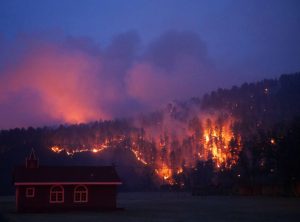 Every year, my husband, Bob Schulenberg and I spend a week around the Fourth of July hiking in the Black Hills. We have been coming to the Black Hills for about 30 years, and it never gets old. I suppose it might if all we did was the normal touristy things, but when you get back in the wilderness areas of the Black Hills, it really is a whole different world, and it’s ever changing, especially when there is a heavy fire year. Unfortunately, this year seems to have been a fire year, at least in the Wildlife Loop of Custer State Park. The fire started on December 11, 2017, and while the cause of the Legion Lake Fire officially remains under investigation, it is believed to have been a downed power line that sparked the blaze. The wildfire shut down Custer State Park
Every year, my husband, Bob Schulenberg and I spend a week around the Fourth of July hiking in the Black Hills. We have been coming to the Black Hills for about 30 years, and it never gets old. I suppose it might if all we did was the normal touristy things, but when you get back in the wilderness areas of the Black Hills, it really is a whole different world, and it’s ever changing, especially when there is a heavy fire year. Unfortunately, this year seems to have been a fire year, at least in the Wildlife Loop of Custer State Park. The fire started on December 11, 2017, and while the cause of the Legion Lake Fire officially remains under investigation, it is believed to have been a downed power line that sparked the blaze. The wildfire shut down Custer State Park  that Monday, and burned an estimated 54,000 acres. It was believed to have started about 7:30 that morning.
that Monday, and burned an estimated 54,000 acres. It was believed to have started about 7:30 that morning.
The winds didn’t help matters either, gusting to 50 miles per hour. The fire moved along the Centennial Trail toward Star Academy East Campus ad Badger Hole. By Monday afternoon the head of the fire had crossed Heddy Draw and spread to both sides of Barnes Canyon Road. the ponderosa pines in the area were burned to the crown. It was so strange to see the green tops of the trees above the burnt orange lower sections of the trees and the blackened trunks.

Most of the wildlife fared well. The 860 bison that call the park home were left unscathed, but three of the park’s beloved begging burros had to be euthanized after the blaze. That is probably the saddest part of this for me, because we love the burros. They are gentle enough to eat out of your hand, and the love the attention everyone gives them. A few more of the burros still face an unknown fate due to the burns they received. The smell of a campfire that burned too long hung in the dry western South Dakota air for a long time. While we couldn’t smell the scorched trees any more, the scars were still visible everywhere.
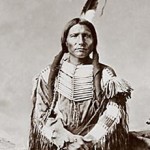 Most people have heard of Crazy Horse, the Lakota Sioux Indian who has been memorialized in the Black Hills. Most of us know that Crazy Horse was a great warrior, but I did not know much about his upbringing. Crazy Horse was born on the Republican River about 1845. Crazy Horse was an uncommonly handsome man, and a man of refinement and grace. He was as modest and courteous as Chief Joseph, but unlike Chief Joseph, Crazy Horse was a born warrior, but a gentle warrior, a true brave, who stood for the highest ideal of the Lakota Sioux people. Of course, you would never hear these things from his enemies, but history should probably judge him more by the accounts of those who knew him…his own people.
Most people have heard of Crazy Horse, the Lakota Sioux Indian who has been memorialized in the Black Hills. Most of us know that Crazy Horse was a great warrior, but I did not know much about his upbringing. Crazy Horse was born on the Republican River about 1845. Crazy Horse was an uncommonly handsome man, and a man of refinement and grace. He was as modest and courteous as Chief Joseph, but unlike Chief Joseph, Crazy Horse was a born warrior, but a gentle warrior, a true brave, who stood for the highest ideal of the Lakota Sioux people. Of course, you would never hear these things from his enemies, but history should probably judge him more by the accounts of those who knew him…his own people.
No matter what Crazy Horse the man was or was thought to be, Crazy Horse, the boy showed great bravery a number of times. In those days, the Sioux prided themselves on the training and development of their sons and daughters, and not a step in that development was overlooked as an excuse to bring the child before the public by giving a feast in its honor. At such times the parents often gave so generously to the needy that they almost impoverished themselves, thus setting an example to the child of self-denial for the general good. His first step alone, the first word spoken, first game killed, the attainment of manhood or womanhood, each was the occasion of a feast and dance in his honor, at which the poor always benefited to the full extent of the parents’ ability. He was carefully brought up according to the tribal customs. I suppose it would have put him in the Indian version of today’s high society.
He was about five years old when the tribe was snowed in one severe winter. They were very short of food, but his father tirelessly hunted for food. The buffalo, their main dependence, were not to be found, but he was out in the storm and cold every day and finally brought in two antelopes. Young Crazy Horse got on his pet pony and rode through the camp, telling the old folks to come to his mother’s teepee for meat. Neither his father nor mother had authorized him to do this, and before they knew it, old men and women were lined up before the teepee home, to receive the meat, in answer to his invitation. As a result, the mother had to distribute nearly all of it, keeping only enough for two meals. On the following day he asked for food. His mother told him that the old folks had taken it all, and added: “Remember, my son, they went home singing praises in your name, not my name or your father’s. You must be brave. You must live up to your reputation.” And so he did.
When he was about twelve he went to look for the ponies with his little brother, whom he loved much, and took a great deal of pains to teach what he had already learned. They came to some wild cherry trees full of ripe fruit. Suddenly, the brothers were startled by the growl and sudden rush of a bear. Young Crazy Horse pushed his brother up into the nearest tree and then jumped upon the back of one of the horses, which was frightened and ran some distance before he could control him. As soon as he could, he turned him about and came back, yelling and swinging his lariat over his head. The bear at first showed fight but finally turned and ran. The old man who told me this story added that young as he was, he had some power, so that even a grizzly did not care to tackle him. I believe it is a fact that a grizzly will dare anything except a bell or a lasso line, so he accidentally hit upon the very thing which would drive him off.
At this period of his life, as was customary with the best young men, he spent much time in prayer and solitude. Just what happened in these days of his fasting in the wilderness and upon the crown of bald buttes, no one will ever know. These things may only be known when one has lived through the battles of life to an honored old age. He was much sought after by his youthful associates, but was noticeably reserved and modest. Yet, in the moment of danger he at once rose above them all…a natural leader! Crazy Horse was a typical Sioux brave, and from the point of view of the white man, an ideal hero.
At the age of sixteen he joined a war party against the Gros Ventres. He was well in the front of the charge, 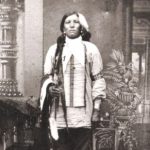 and at once established his bravery by following closely one of the foremost Sioux warriors, by the name of Hump, drawing the enemy’s fire and circling around their advance guard. Suddenly Hump’s horse was shot from under him, and there was a rush of warriors to kill or capture him while he was down. Amidst a shower of arrows Crazy Horse jumped from his pony, helped his friend into his own saddle, sprang up behind him, and carried him off to safety, although they were hotly pursued by the enemy. Thus, in his first battle he associated himself with the wizard of Indian warfare, and Hump, who was then at the height of his own career. Hump pronounced Crazy Horse the coming warrior of the Teton Sioux. He was killed at Fort Robinson, Nebraska, in 1877, so that he lived barely thirty-three years.
and at once established his bravery by following closely one of the foremost Sioux warriors, by the name of Hump, drawing the enemy’s fire and circling around their advance guard. Suddenly Hump’s horse was shot from under him, and there was a rush of warriors to kill or capture him while he was down. Amidst a shower of arrows Crazy Horse jumped from his pony, helped his friend into his own saddle, sprang up behind him, and carried him off to safety, although they were hotly pursued by the enemy. Thus, in his first battle he associated himself with the wizard of Indian warfare, and Hump, who was then at the height of his own career. Hump pronounced Crazy Horse the coming warrior of the Teton Sioux. He was killed at Fort Robinson, Nebraska, in 1877, so that he lived barely thirty-three years.
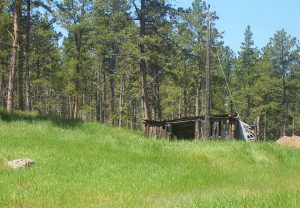 “Every state has ghost towns. Eastern and Midwestern States are no exception. At one time or another you may have driven your car right by a ghost town, not aware of it. If you are a hiker, backpacker, or a hunter, you may have walked past or through a ghost town not knowing one was there.” I read that statement on a web site I was using to research stories for my blog. I had read many stories about ghost towns, but this one intrigued me. My husband, Bob Schulenberg and I have hiked many of the trails in the Black Hills, and I can’t even begin to count the number of times we have walked past old abandoned, crumbling, falling down buildings. To us, they seemed like just an abandoned farmhouse and out buildings, but now I am beginning to wonder if we have been one of those hikers who have walked right through a ghost town, and didn’t even know it. In fact, I’ll bet we have walked right through many a ghost town during our many hikes.
“Every state has ghost towns. Eastern and Midwestern States are no exception. At one time or another you may have driven your car right by a ghost town, not aware of it. If you are a hiker, backpacker, or a hunter, you may have walked past or through a ghost town not knowing one was there.” I read that statement on a web site I was using to research stories for my blog. I had read many stories about ghost towns, but this one intrigued me. My husband, Bob Schulenberg and I have hiked many of the trails in the Black Hills, and I can’t even begin to count the number of times we have walked past old abandoned, crumbling, falling down buildings. To us, they seemed like just an abandoned farmhouse and out buildings, but now I am beginning to wonder if we have been one of those hikers who have walked right through a ghost town, and didn’t even know it. In fact, I’ll bet we have walked right through many a ghost town during our many hikes.
I love photographing old buildings, and often find myself wondering how long they had been there, and why 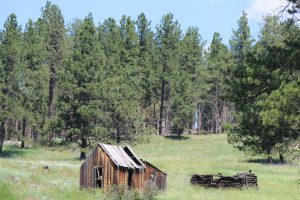 they were left to rot. Of course, the Black Hills is rich in gold rush history, so a ghost town or tow makes perfect sense. We have driven through, and by some of them, and even passed through some while riding he 1880 Train, but for some reason, it didn’t occur to me that some of the old buildings we have hiked by could have been part of a ghost town, but looking back now, it makes perfect sense. I have often found myself wondering who lived there and what their lives might have been like back when the house was newly built. Still, it didn’t occur to me that it might be part of a ghost town. I guess that is because I always thought that all the ghost towns would be well documented with signs alerting the tourists to the site. In reality, those signs would be placed by the town’s owner, who was trying to make a buck by romanticizing the site…and that’s ok too, but that doesn’t mean that every ghost town was so well documented. In reality, it’s the ghost towns that are less documented that hold the most intrigue, because much less is known about them.
they were left to rot. Of course, the Black Hills is rich in gold rush history, so a ghost town or tow makes perfect sense. We have driven through, and by some of them, and even passed through some while riding he 1880 Train, but for some reason, it didn’t occur to me that some of the old buildings we have hiked by could have been part of a ghost town, but looking back now, it makes perfect sense. I have often found myself wondering who lived there and what their lives might have been like back when the house was newly built. Still, it didn’t occur to me that it might be part of a ghost town. I guess that is because I always thought that all the ghost towns would be well documented with signs alerting the tourists to the site. In reality, those signs would be placed by the town’s owner, who was trying to make a buck by romanticizing the site…and that’s ok too, but that doesn’t mean that every ghost town was so well documented. In reality, it’s the ghost towns that are less documented that hold the most intrigue, because much less is known about them.
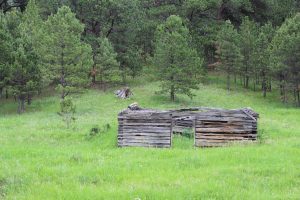 I think that the next time we hike and find ourselves passing by an old rotting building, that I will feel much different about the place than I did in the past. I think I will still wonder about who lived there, but also about whether or not it was a ghost town that once sprung up, and prospered, only to be choked out when hard times hit and the people who lived there moved on in search of a better life. That was, after all, the fate of every ghost town. It was a town that sprung up with the promise of becoming a bustling city, but it was in the wrong place, and life could not be sustained there, so eventually it withered and died off, leaving only the buildings to tell of its presence, and then only to those who happened to pass by.
I think that the next time we hike and find ourselves passing by an old rotting building, that I will feel much different about the place than I did in the past. I think I will still wonder about who lived there, but also about whether or not it was a ghost town that once sprung up, and prospered, only to be choked out when hard times hit and the people who lived there moved on in search of a better life. That was, after all, the fate of every ghost town. It was a town that sprung up with the promise of becoming a bustling city, but it was in the wrong place, and life could not be sustained there, so eventually it withered and died off, leaving only the buildings to tell of its presence, and then only to those who happened to pass by.
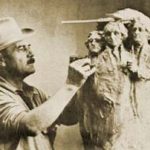
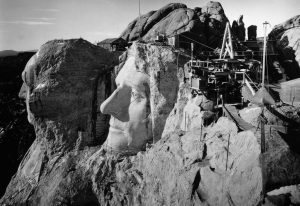 When a construction project begins, it usually takes a matter of a few months to complete. That is not how it works when carving a large sculpture, such as Mount Rushmore. Mount Rushmore National Memorial is a sculpture carved into the granite face of Mount Rushmore, a batholith in the Black Hills in Keystone, South Dakota, United States. It was the vision of Doane Robinson, who thought that carving the faces of famous people in the Granite of the Black Hills region, would bring tourists to the region. Robinson’s vision has proven to be an amazing success. His original idea was to put the sculpture in the area of the Needles, but the chosen sculptor, Gutzon Borglum rejected the idea because of the poor quality of the granite, and strong opposition from the Native American Groups in the area. I’m glad it didn’t go in the needles area, because they have a beauty all their own, and it would have been a shame to change them.
When a construction project begins, it usually takes a matter of a few months to complete. That is not how it works when carving a large sculpture, such as Mount Rushmore. Mount Rushmore National Memorial is a sculpture carved into the granite face of Mount Rushmore, a batholith in the Black Hills in Keystone, South Dakota, United States. It was the vision of Doane Robinson, who thought that carving the faces of famous people in the Granite of the Black Hills region, would bring tourists to the region. Robinson’s vision has proven to be an amazing success. His original idea was to put the sculpture in the area of the Needles, but the chosen sculptor, Gutzon Borglum rejected the idea because of the poor quality of the granite, and strong opposition from the Native American Groups in the area. I’m glad it didn’t go in the needles area, because they have a beauty all their own, and it would have been a shame to change them.
They settled on Mount Rushmore, which also has the advantage of facing southeast for maximum sun exposure, which makes the faces of our presidents stand out in an amazing way. Robinson wanted it to feature American West heroes like Lewis and Clark, Red Cloud, and Buffalo Bill Cody, but Borglum decided the sculpture should have broader appeal and chose the four presidents. Borglum created the sculpture’s design and oversaw the project’s execution from 1927 to 1941 with the help of his son, Lincoln Borglum. When I think of the years it too to complete the sculpture, I wonder if it was what was expected, or just the way it came down. Mount Rushmore features 60-foot sculptures of the heads of four United States presidents…George Washington (1732–1799), Thomas Jefferson (1743–1826), Theodore Roosevelt (1858–1919), and Abraham Lincoln (1809–1865). After securing federal funding through the enthusiastic sponsorship of “Mount Rushmore’s great political patron” US Senator Peter Norbeck, construction on the memorial began in 1927, and the presidents’ faces were completed between 1934 and 1939. Upon Gutzon Borglum’s death in March 1941, his son Lincoln Borglum took over as leader of the construction project. Each president was originally to be depicted from head to waist.
The memorial park covers 1,278.45 acres and is 5,725 feet above sea level, and while the sculpture work officially ended on October 31, 1941, due to lack of funding and the very real possibility of a United States entrance into World War II. Mount Rushmore has become an iconic symbol of the United States, and it has 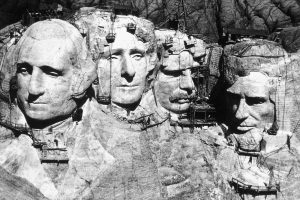
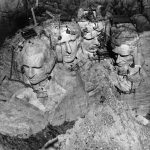 appeared in works of fiction, as well as being discussed or depicted in other popular works. It has also been featured a number of movies. It attracts over two million visitors annually. It’s amazing to me that what started out to be a tourist attraction, quickly became a must see place for every patriotic American. My husband and I love to go to the Black Hills, and with the close proximity to our Casper, Wyoming home, we take a week every summer to go and enjoy the beauty and patriotism that now resides there.
appeared in works of fiction, as well as being discussed or depicted in other popular works. It has also been featured a number of movies. It attracts over two million visitors annually. It’s amazing to me that what started out to be a tourist attraction, quickly became a must see place for every patriotic American. My husband and I love to go to the Black Hills, and with the close proximity to our Casper, Wyoming home, we take a week every summer to go and enjoy the beauty and patriotism that now resides there.

